
Nutrient Management Planning for Poultry-Grain Agriculture
 |
Nutrient Management Planning for Poultry-Grain Agriculture |
Overview of Nutrient Management
Nutrient Management is a decision making process essential to the long-term sustainability of production agriculture. The fundamental goal of nutrient management is to identify the most profitable and environmentally sound approach to provide crops with an optimum supply of nutrients. An optimum nutrient supply is the amount needed to attain realistic crop yields, prevent nutrient accumulation in soil, and minimize unprofitable and environmentally harmful nutrient losses from soil. In Delaware, effective nutrient management is of particular concern because of the potential for contamination of ground waters by nitrogen (N) and surface waters by N and phosphorus (P).
Basic Principles of Nutrient Management
An effective nutrient management program should be based on the latest scientific research and should have a broad, long-term perspective. It should focus not just on the nutrient requirements of individual crops or the soil test nutrient levels in individual fields, but on nutrient cycles throughout the farm. All factors that influence nutrient supply to crops and off-farm nutrient loss should be considered thoroughly to prevent the undesirable impacts associated with ground and surface water pollution. The principles and practices to be followed when developing a comprehensive nutrient management plan have been described in detail by Sims and Gartley (1996). The key steps in any such plan are to:
Delaware's Poultry-Grain Agriculture
Delaware's poultry industry is vital to the state's economy and agricultural community. Nearly 270 million broiler chickens with an economic value of almost a half billion dollars are produced each year. Poultry are produced primarily in Sussex County, which has about 250,000 acres of cropland used for corn, soybean, small grains, and vegetables. The poultry industry annually generates manure, litter, compost, and processing plant sludges. Presently the only economically viable use for these wastes is application to agricultural fields as a source of crop nutrients. Best management practices (BMPs) for the use of poultry wastes as agricultural soil amendments have been developed based on years of research in Delaware and other states with similar soils and crops. Information on these BMPs is available from University of Delaware Cooperative Extension and from state and local advisory agencies, such as USDA-NRCS.
Nutrient Balance in Poultry-Grain Agriculture
Geographic intensification of animal production, as has occurred with Delaware's poultry industry, frequently creates problems with farm and watershed scale nutrient balances. Nutrient inputs to farms in feed and fertilizers often exceed outputs in animal products and harvested crops. Long-term, on-farm nutrient surpluses increase the potential for nutrient accumulation in soils to levels in excess of crop needs (P) and for nutrient losses to ground waters (N) and surface waters (N and P). Nutrient management plans for intensive animal-based agriculture must focus more on farm-scale nutrient balance rather than exclusively on field-scale crop response to nutrients applied in animal wastes. Nutrient management plans that balance farm-scale nutrient inputs and outputs avoid on-farm nutrient surpluses, minimize the impact of off-farm nutrient losses, and optimize economic returns. The purpose of this fact sheet is to demonstrate a simple, straightforward approach for constructing a farm-scale nutrient "budget" for poultry-grain agriculture, which is vital to the long-term planning required to ensure agricultural sustainability.
Constructing a Farm-Scale Nutrient Budget
A nutrient budget should be based on accurate grower records and sound nutrient management practices. Farm nutrient inputs should be calculated from analyses of feed and fertilizer provided by suppliers and from estimates of biological N fixation. Geographic distribution of nutrients on the farm should be monitored with soil tests and by animal waste and crop nutrient analyses to estimate nutrient supply to and removal from cropland. Farm nutrient outputs should be based on standard composition values for the nutrient content of animals and crops, or actual nutrient analyses of animal and grain products, and estimates of atmospheric nutrient losses, which is a concern primarily for ammonia-N (NH3-N). The following nutrient budget is constructed for a typical poultry-grain farm on the Delmarva Peninsula. Farm characteristics are based on information from Michel et al. (1996), poultry and feed characteristics are based on information from Malone (1997), Saylor (1997), and U.S. National Resource Council (1982), and soil and crop characteristics are based on information from Sims and Gartley (1996), Sims and Vadas (1997), U.S. National Resource Council (1982), and Vasilas et al. (1991).
Section I
Farm Characteristics and Nutrient Inputs to and Outputs from the Farm
I. Farm Characteristics
II. Nutrient Inputs in Animals and Animal Feed
Table 1. Nutrient inputs to the farm in chicks.

Table 2. Nutrient inputs to the farm in feed.
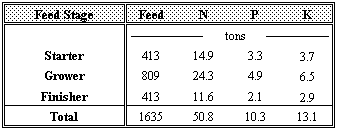
Table 3. Nutrient inputs required for corn.
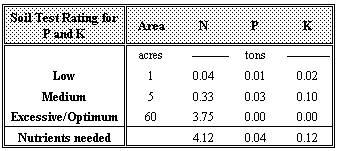
Table 4. Nutrient inputs required for soybeans.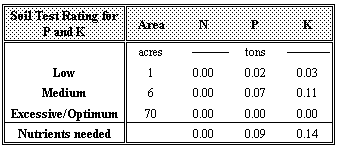
Table 5. Nutrient inputs required for wheat/soybeans.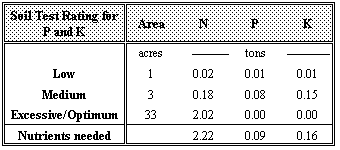
IV. Nutrient Outputs in Animals
Table 6. Nutrient outputs in broilers.
V. Nutrient Outputs in Crops
Table 7. Nutrient outputs in crops.
Note: Soybean yields include full-season and double-cropped.
Section II
Land Application of Poultry Litter and Supplemental Fertilizer Inputs
Essentially all P and K brought onto the farm in animal feed will either leave the farm in animal products or accumulate in poultry litter. The P and K in poultry litter will be available for crop uptake following land application of the litter. For N, research suggests that as much as 30% of feed N brought onto the farm will be lost from poultry houses through NH3-N volatilization. The remaining N will either leave the farm in animal products or accumulate in poultry litter. Only about 60% of the N that accumulates in poultry litter is available to crops following land application of the litter. Given these assumptions, Table 8 summarizes the nutrient requirements of all crops (See Tables 3, 4, and 5), the nutrients available in poultry litter, and any fertilizer nutrients that must be purchased and brought onto the farm to supplement nutrients not supplied with poultry litter. Table 8 clearly shows that for this situation there are enough available nutrients in poultry litter to meet all crop requirements. Therefore, supplemental fertilizer nutrients do not need to be purchased.
Table 8. Nutrients needed by crops, available in poultry litter, and to
be purchased in fertilizer.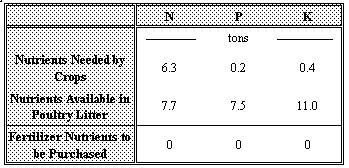
Section III
Complete Farm Nutrient Budget Summary
Nutrient Budget Summary
Tables 9, 10, and 11 summarize total nutrient inputs to the farm, total nutrient outputs from the farm, and the on-farm nutrient balance. Again, research has shown that up to 30 % of feed N (Table 10) may be lost from poultry houses through NH3-N volatilization.
Table 9. Total nutrient inputs to the farm.
Note: The N input for soybeans is from biological N fixation, and
soybeans fix 1.8 pounds of N per bushel.
Table 10. Total nutrient outputs from the farm.
Note: Total N outputs do not include NH3-N volatilization
losses.
Table 11. Farm nutrient surplus or deficit.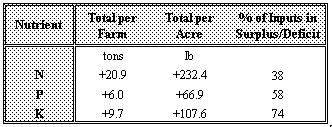
Comparison of Typical Farm with No-Farm Scenario
Information from Michel et al. (1996) shows that in Delmarva, 64% of poultry farmers surveyed have no cropland available for land application of the poultry litter they generate. The following nutrient budget (Table 12) is constructed for such a farm and is based upon the same information used earlier to construct the nutrient budget for the typical poultry-grain farm.
On the farm, there are 2 poultry houses with 22,000 birds per house and 5 flocks per year. The only nutrient inputs to the farm are chicks and broiler feed, and the only nutrient outputs from the farm are animals. Essentially, all surplus nutrients on the farm (except for N lost through NH3-N volatilization) will accumulate in poultry litter. If poultry litter was land applied based on the crop N needs, yield goals, and plant available N content of poultry litter outlined for the typical farm earlier, then 5.1 tons of N would be available in poultry litter to land apply. Corn would require about 125 pounds of N per acre and the wheat/soybeans double crop would require about 120 pounds of N per acre. Soybeans require no N, so poultry litter would not be applied to soybean acreage. Given these crop N requirements, approximately 52 acres of cropland planted to corn and 31 acres of cropland planted to wheat/soybeans would be required for poultry litter application. This is an average of about 42 acres of cropland per poultry house.
Table 12. Total nutrient budget for the farm.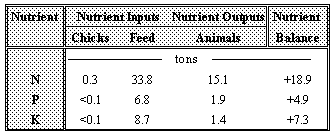
Implications of Nutrient Budgets for Poultry-Grain Agriculture
The nutrient budgets outlined above clearly show that the largest input of nutrients to poultry-grain farms, and thus the primary source of any on-farm nutrient excess, is animal feed, and not commercial fertilizers. This scenario is consistent with other concentrated animal production industries, including dairy and swine. Therefore, developing nutrient management practices in Delaware that attain on-farm nutrient balance must be a multi-disciplinary effort that combines the poultry dietary management expertise of animal scientists and the animal industry as a whole with the field-scale nutrient management expertise of agronomists and soil scientists. The nutrient budgets outlined above also show that current management practices on poultry-grain farms in Delaware will result in an excess of on-farm nutrients and ultimately an on-farm nutrient accumulation. To develop farm-scale nutrient management practices that prevent the loss of accumulating nutrients to the environment, it is vital to identify and understand all possible pathways for nutrient export from the farm. These pathways are illustrated in Figure 1.
Figure 1. Schematic representation of pathways for nutrient inputs to a poultry-grain farm, nutrient outputs from the farm, nutrient cycling on the farm, and nutrient losses to the environment.
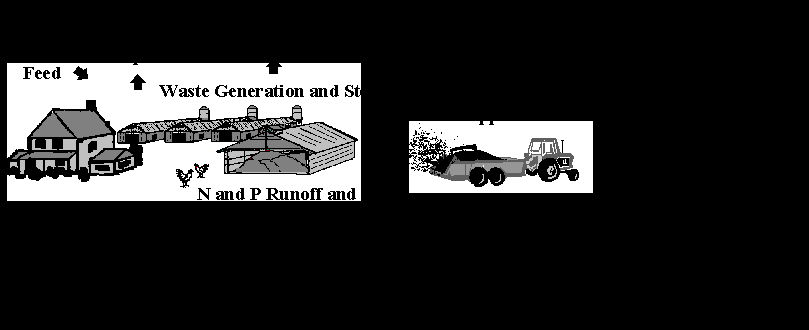
Fate of Excess Nutrients
Nitrogen and P are the nutrients of greatest environmental concern in Delaware because of their well documented effects on ground and surface water quality. Since animal feeds are the largest input of nutrients to the farm, excess nutrients will initially accumulate in animal waste. During waste generation and storage, N and P may be lost in leaching or runoff from open facilities, but the majority of excess nutrients will remain in the waste. Some waste may be exported from the farm for uses other than land application, but the bulk of it will be land applied. Once applied, N and P may be taken up by crops and removed during harvest. When applied in excess of crop needs or during times of low crop uptake, N and P may be lost to the environment through leaching, erosion, surface runoff, or subsurface lateral water flow. The ultimate sinks for N and P lost through these pathways will be ground water and surface water. Previous research also suggests that as much as 30% of total N brought onto the farm in feed can be lost to the atmosphere as volatilized NH3-N during waste generation in poultry houses, waste storage, and waste application to cropland. Emerging regional and international concerns about the effects of NH3-N on air quality, the re-deposition of NH3-N in rainfall on surface water quality and soil quality in forests and other natural ecosystems suggest that NH3-N volatilization is not desirable.
Nutrient Management Options
When nutrient inputs to a farm exceed nutrient outputs, either inputs must be reduced or outputs must be increased to obtain a nutrient balance. For poultry-grain agriculture in Delaware, reducing inputs may include decreasing nutrient supplements in feed (e.g., using supplemental phytase or low-phytate corn feed), maximizing feed efficiency to reduce waste, and eliminating unnecessary fertilizer applications to fields. Increasing outputs may include developing off-farm uses of poultry litter as alternatives to land application (e.g., value added products, bioenergy, poultry litter composting or pelleting, or the use of poultry litter in synthetic topsoils). Even when inputs and outputs can be balanced, there must also be efficient on-farm use of nutrients to prevent non-point losses of nutrients to the environment. Because reclamation of nutrient impaired groundwater and surface water is difficult and expensive, the ideal way to protect these resources is to avoid on-farm nutrient accumulation and prevent nutrient loss from waste storage facilities and cropland by implementing best management practices. Table 13 outlines current nutrient management options. More detailed information on these topics is available in other University of Delaware publications, particularly the Nutrient Management Handbook for Delaware (Sims and Gartley, 1996).
Table 13. Management options to reduce nutrient loss in leaching, runoff, erosion, and volatilization.
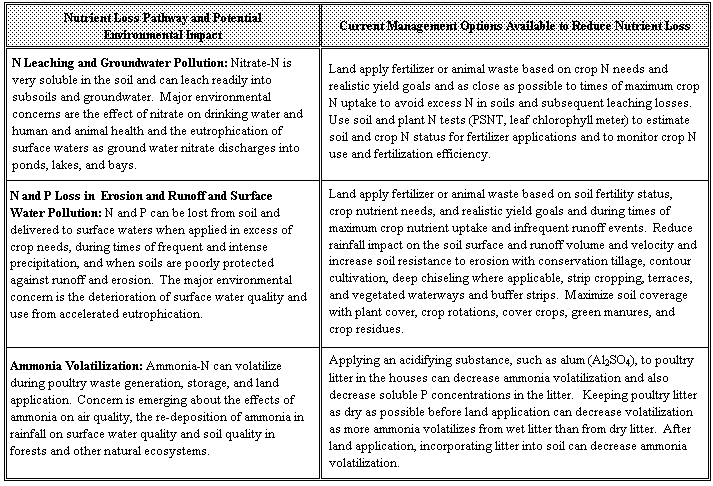
References
Malone, G. 1997. Personal Communication.
Michel, K., J.R. Bacon, and C.M. Gempesaw II. 1996. Nutrient management by Delmarva poultry growers: A survey of attitudes and options. University of Delaware. Newark, DE. FREC-RR 96-01.
Saylor, W.W. 1997. Personal Communication.
Sims, J.T. and D.C. Wolf. 1994. Poultry waste management: Agronomic and environmental issues. Adv. Agron. 52:1-83.
Sims, J.T. and K.L. Gartley. 1996. Nutrient Management Handbook for Delaware. University of Delaware. Newark, DE. Cooperative Bulletin #59.
Sims, J.T. and P.A. Vadas. 1997. Soil test phosphorus status and trends in Delaware. University of Delaware. Newark, DE. Cooperative Bulletin ST-09.
U.S. National Resource Council. 1982. United States-Canadian tables of feed composition. Nat. Acad. Press, Washington, D.C.
Vasilas, B.L., R.W. Taylor, J.T. Sims, and J.J Fuhrmann. 1991. Soybeans in crop rotations. University of Delaware. Newark, DE. Cooperative Bulletin SF-25.
The references listed below were not used directly to prepare this fact sheet. They are listed as supplemental information on nutrient management as it pertains to environmental quality, animal wastes, soil testing, fertilizer management practices, and nitrogen and phosphorus in general. A complete reference list is available in the Nutrient Management Handbook for Delaware (Sims and Gartley, 1996).
Gartley, K.L. and J.T. Sims. 1994. Phosphorus soil testing: Environmental uses and implications. Comm. Soil Sci. Plant Anal. 25:1565-1582.
Hatfield, J.L. 1995. Effective management of animal waste as a soil resource. John Wiley and Sons, NY.
Malone, G. W. 1992. Nutrient enrichment in integrated broiler production systems. Poultry Sci. 71:1117-1122.
Pierzynski, G.M., J.T. Sims, and G.F. Vance. 1994. Soils and environmental quality. Lewis Publishers, Inc., Chelsea, MI.
Ritter, W.F. 1992. Delaware’s Inland Bays: A case study. J. Environ. Sci. and Health, Part A - Environ. Sci. and Eng. A27:63-68.
Ritter, W.F. and J.R. Harris. 1984. Nonpoint source nitrogen loads to Delaware lakes and streams. Agric. Waste. J. 9(1):35-45.
Sharpley, A.N., T.C. Daniel. J.T. Sims, and D.H. Pote. 1996. Determining environmentally sound soil phosphorus levels. J. Soil Water Conserv. 51(2):160-166.
Sharpley, A.N., J.T. Sims, T.C. Daniel, R. Wedepohl, and S. Chapra. 1994. Managing agricultural phosphorus for protection of surface waters: Issues and options. J. Environ. Qual. 23:437-541.
Sims, J.T. 1994. Environmental soil testing for phosphorus. J. Prod. Agric. 6:501-507.
Sims, J.T. 1994. Animal waste management. p. 185-201. Encyclopedia of agricultural sciences. Academic Press, Orlando, FL.
Steele, K. 1995. Animal wastes and the land-water interface. Lewis Publishers, Boca Raton, FL.
Click here to close and return to the STP Publications Page